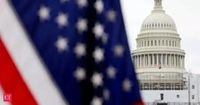Consumer confidence in the United States took another hit in September 2025, with the University of Michigan’s closely watched Consumer Sentiment Index falling sharply, signaling mounting anxiety over inflation, job security, and trade policy. The preliminary reading for September dropped to 55.4, down from 58.2 in August, according to the University of Michigan’s release on September 12, 2025. This figure not only missed market expectations of 58 but also marked a 4.8% decline from the previous month, extending a worrying trend that has persisted throughout the year.
The details of the report, covered by outlets such as Yahoo Finance and The Economic Times, paint a picture of broad-based unease. Both the Current Conditions Index and the Expectations Index registered declines—falling to 61.2 from 61.7 and to 51.8 from 55.9, respectively. This suggests that Americans are feeling less confident not just about their current financial situations, but also about the future.
Joanne Hsu, director of the University of Michigan’s Surveys of Consumers, summed up the prevailing mood: “Consumers continue to note multiple vulnerabilities in the economy, with rising risks to business conditions, labor markets, and inflation.” She added, “Current and expected personal finances both eased about 8% this month.” These findings were echoed in US News, which highlighted that the decrease in sentiment was visible across age, income, and wealth groups.
Compared to the same period last year, sentiment has plummeted by 21%, underscoring just how much more pessimistic Americans have become. The survey’s findings suggest that the optimism seen during the summer has all but evaporated, and households are bracing for tougher times ahead.
One of the most striking aspects of the survey is the persistent anxiety about inflation. The measure of one-year inflation expectations remained at a high 4.8%, unchanged from August. But perhaps more concerning for policymakers, the five-year inflation expectation jumped to 3.9% from 3.5%. This uptick suggests that Americans are increasingly skeptical that the Federal Reserve will be able to bring inflation under control in the medium term—a trend that central bankers watch with particular concern, as it can make inflation harder to tame if it becomes embedded in consumer psychology.
Trade policy is also weighing heavily on consumers’ minds. Around 60% of survey respondents made unprompted references to tariffs, a figure that has held steady since last month. As Yahoo Finance and the University of Michigan both noted, these concerns are especially pronounced among lower- and middle-income households, who are often more sensitive to price increases on imported goods. The ongoing legal and political battles over President Donald Trump’s tariffs, now facing scrutiny from the Supreme Court, have only added to the uncertainty.
Labor market worries are compounding the gloom. About 65% of consumers now expect higher unemployment in the next 12 months, up from around 60% in August—a level not seen since the depths of the Great Recession. Recent data from the US Labor Department revealed that payrolls dropped by 13,000 in June, marking the first net loss of jobs since December 2020. Moreover, revisions to earlier payroll data showed that 911,000 fewer jobs were created over the past year than initially reported. The New York Federal Reserve’s survey further underscored the malaise, finding that Americans’ confidence in finding new jobs after a layoff is now at its lowest point since June 2013.
“The U.S. economy faces risks in the view of the consumer and this makes a Fed rate cut all the more likely next week,” said Chris Rupkey, chief economist at fwdbonds, as reported by US News. He added, “If the consumer is not winning, the economy won’t be either.”
Inflation, meanwhile, continues to outpace the Federal Reserve’s 2% target. In August, the annual inflation rate rose to 2.9%, up from 2.7% in July. While this is not as alarming as the rapid price increases seen earlier in the decade, it remains a persistent thorn in the side of policymakers and households alike.
The market reaction to the consumer sentiment data was swift. The US Dollar Index briefly retreated from session highs before recovering to end the day 0.2% higher at 97.70, as reported by FXStreet. However, the broader context is less rosy for the greenback, which has been under pressure amid fears that the Federal Reserve may be falling behind the curve in its efforts to support the economy.
Analysts widely expect that the latest data will strengthen the case for the Federal Reserve to cut interest rates at its upcoming meeting. “While today’s inflation numbers remain above the Fed’s stated 2% target the data is not as concerning for the Fed as the rapidly weakening employment data from the last couple of months, paving the way for a rate cut at their meeting next week,” said Dominic Pappalardo, chief multi-asset strategist at Morningstar Wealth, according to US News.
Looking at the bigger picture, the University of Michigan’s Consumer Sentiment Index is considered a leading indicator for US economic trends, given that consumer spending accounts for a significant portion of the nation’s GDP. The steady deterioration of this gauge over the past year—now nearly 15% below its August 2024 level—reflects the cumulative impact of inflation, weak job growth, and trade tensions on American households.
Buying conditions for durable goods, such as cars and appliances, showed some improvement, but this was a rare bright spot in an otherwise downbeat report. All other components of the index moved lower, reinforcing the sense that consumers are hunkering down and preparing for economic headwinds.
Some economists warn that if sentiment continues to slide, it could translate into weaker consumer spending, which would further slow economic growth. As Chris Rupkey noted, the rebound in consumer spending seen in the third quarter could quickly evaporate if diminished confidence keeps Americans away from stores and malls.
As the Federal Reserve prepares to meet next week, policymakers face a delicate balancing act: how to support a slowing economy without letting inflation expectations become entrenched. The latest consumer sentiment data is a stark reminder that, for many Americans, the economic recovery remains fragile, and the path forward is anything but certain.
With inflation expectations rising, job security waning, and tariff worries still looming large, it’s clear that consumer confidence will remain a key barometer to watch in the months ahead.





